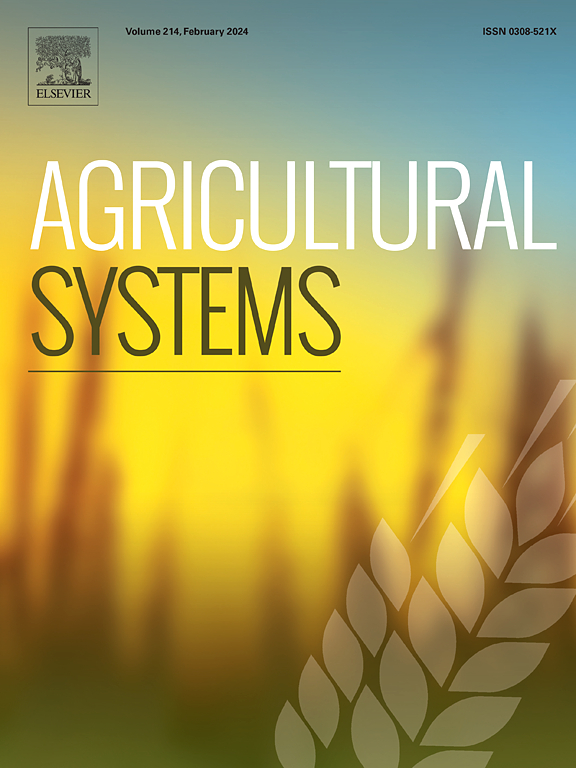减少国家水资源退化:肥料识别框架的发展和应用
IF 6.1
1区 农林科学
Q1 AGRICULTURE, MULTIDISCIPLINARY
引用次数: 0
摘要
背景粪肥区概念通过将剩余粪肥输送到有养分需求的农田,最大限度地减少畜牧密集型农业系统中的养分失衡。本研究建立了一个框架,以评估在美国毗连区(CONUS)范围内基于粪肥区的粪肥养分管理所产生的影响及其改善土壤养分动态和水质的潜力。方法根据历史上的农艺氮(N)和磷(P)需求以及最近的粪肥类型(湿粪与干粪)的运输潜力,在全美范围内划分粪肥区,从而平衡县级规模的粪肥进出口。利用土壤水评估工具 (SWAT+) 开发的国家农业生态系统模型 (NAM),对美国东南部奥科尼河流域进行了基于肥料区的养分管理对水质影响的评估。结果和结论分析发现,近 78% 的湿粪过剩县(152 个县)只需要两个邻近县来平衡过量的湿粪磷,约 77% 的干粪过剩县(428 个县)只需要三个邻近县来平衡过量的干粪磷。根据作物对磷的需求重新分配过剩粪肥后,流域出口处的总养分负荷有所下降,总氮 (TN) 降低了 0.44%,总磷 (TP) 降低了 3.41%。然而,过量粪肥的重新分配导致下奥科尼河(粪肥汇集流域)的养分负荷略有增加。研究结果强调,通过空间明确和适应性强的管理策略,基于粪肥分区的方法可成功平衡各区域的养分流,从而提高粪肥养分利用效率并改善水质。本文章由计算机程序翻译,如有差异,请以英文原文为准。

Reducing national water degradation: Development and application of a manureshed-identification framework
Context
The manureshed concept minimizes nutrient imbalance in livestock-intensive agricultural systems by transporting surplus manure to agricultural fields with nutrient demands. The impacts of manureshed-based manure management across the contiguous United States (CONUS) and its potential to improve soil nutrient dynamics and water quality are not well known.
Objective
This study developed a framework to evaluate the impacts of manureshed-based manure nutrient management at the CONUS scale.
Methods
Across CONUS, county-scale manure imports and exports were balanced by delineating manuresheds according to historic agronomic nitrogen (N) and phosphorus (P) demands and the transportation potentials of the nearest manure types (wet vs. dry). The water quality impacts of manureshed-based nutrient management were assessed for the Oconee River Watershed, in the southeastern United States using the National Agroecosystems Model (NAM) developed from the Soil Water Assessment Tool (SWAT+).
Results and conclusions
The analysis identified that nearly 78 % of the wet manure surplus counties (152 counties) required only two neighboring counties to balance excess wet manure P, and about 77 % of dry manure surplus counties (428 counties) required only three neighboring counties to balance excess dry manure P. The P-balanced manureshed-based manure management reduced organic phosphorus (P) by 29 % and organic nitrogen (N) by 5 % in the manure surplus case study watershed (Upper Oconee). When the excess manure was redistributed based on crop P demand, the total nutrient load at the watershed outlet decreased, with a 0.44 % reduction in total nitrogen (TN) and a 3.41 % reduction in total phosphorus (TP). However, the redistribution of excess manure led to a slight increase in nutrient loads in the Lower Oconee, the manure sink watershed.
Significance
The study demonstrates the potential of manureshed-based manure management to reduce nutrient loads. The findings emphasize that with spatially explicit and adaptive management strategies, manureshed-based approaches can successfully balance nutrient flows across regions, leading to better manure nutrient use efficiencies and water quality improvement.
求助全文
通过发布文献求助,成功后即可免费获取论文全文。
去求助
来源期刊

Agricultural Systems
农林科学-农业综合
CiteScore
13.30
自引率
7.60%
发文量
174
审稿时长
30 days
期刊介绍:
Agricultural Systems is an international journal that deals with interactions - among the components of agricultural systems, among hierarchical levels of agricultural systems, between agricultural and other land use systems, and between agricultural systems and their natural, social and economic environments.
The scope includes the development and application of systems analysis methodologies in the following areas:
Systems approaches in the sustainable intensification of agriculture; pathways for sustainable intensification; crop-livestock integration; farm-level resource allocation; quantification of benefits and trade-offs at farm to landscape levels; integrative, participatory and dynamic modelling approaches for qualitative and quantitative assessments of agricultural systems and decision making;
The interactions between agricultural and non-agricultural landscapes; the multiple services of agricultural systems; food security and the environment;
Global change and adaptation science; transformational adaptations as driven by changes in climate, policy, values and attitudes influencing the design of farming systems;
Development and application of farming systems design tools and methods for impact, scenario and case study analysis; managing the complexities of dynamic agricultural systems; innovation systems and multi stakeholder arrangements that support or promote change and (or) inform policy decisions.
 求助内容:
求助内容: 应助结果提醒方式:
应助结果提醒方式:


